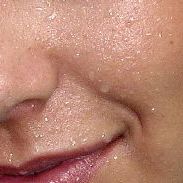
The hippopotamus (; pl.: hippopotamuses; also shortened to hippo, further qualified as the common hippopotamus, Nile hippopotamus, or river hippopotamus, is a large semiaquatic mammal native to sub-Saharan Africa. It is one of only two extant species in the family Hippopotamidae, the other being the pygmy hippopotamus. Its name comes from the ancient Greek for "river horse".

Artiodactyls are placental mammals belonging to the order Artiodactyla. Typically, they are ungulates which bear weight equally on two of their five toes. The other three toes are either present, absent, vestigial, or pointing posteriorly. By contrast, most perissodactyls bear weight on an odd number of the five toes. Another difference between the two orders is that many artiodactyls digest plant cellulose in one or more stomach chambers rather than in their intestine. Molecular biology, along with new fossil discoveries, has found that cetaceans fall within this taxonomic branch, being most closely related to hippopotamuses. Some modern taxonomists thus apply the name Cetartiodactyla to this group, while others opt to include cetaceans within the existing name of Artiodactyla. Some researchers use "even-toed ungulates" to exclude cetaceans and only include terrestrial artiodactyls, making the term paraphyletic in nature.

Hippopotamidae is a family of stout, naked-skinned, and semiaquatic artiodactyl mammals, possessing three-chambered stomachs and walking on four toes on each foot. While they resemble pigs physiologically, their closest living relatives are the cetaceans. They are sometimes referred to as hippopotamids.

The pygmy hippopotamus or pygmy hippo is a small hippopotamid which is native to the forests and swamps of West Africa, primarily in Liberia, with small populations in Sierra Leone, Guinea, and Ivory Coast. It has been extirpated from Nigeria.

Perspiration, also known as sweat, is the fluid secreted by sweat glands in the skin of mammals.

A birthmark is a congenital, benign irregularity on the skin which is present at birth or appears shortly after birth—usually in the first month. Birthmarks can occur anywhere on the skin. They are caused by overgrowth of blood vessels, melanocytes, smooth muscle, fat, fibroblasts, or keratinocytes.

An exudate is a fluid released by an organism through pores or a wound, a process known as exuding or exudation. Exudate is derived from exude 'to ooze' from Latin exsūdāre 'to sweat'.
Body odor or body odour (BO) is present in all animals and its intensity can be influenced by many factors. Body odor has a strong genetic basis, but can also be strongly influenced by various factors, such as sex, diet, health, and medication. The body odor of human males plays an important role in human sexual attraction, as a powerful indicator of MHC/HLA heterozygosity. Significant evidence suggests that women are attracted to men whose body odor is different from theirs, indicating that they have immune genes that are different from their own, which may produce healthier offspring.

The endocrine system is a network of glands and organs located throughout the body. It is similar to the nervous system in that it plays a vital role in controlling and regulating many of the body's functions. Endocrine glands are ductless glands of the endocrine system that secrete their products, hormones, directly into the blood. The major glands of the endocrine system include the pineal gland, pituitary gland, pancreas, ovaries, testicles, thyroid gland, parathyroid gland, hypothalamus and adrenal glands. The hypothalamus and pituitary glands are neuroendocrine organs.

Sweat glands, also known as sudoriferous or sudoriparous glands, from Latin sudor 'sweat', are small tubular structures of the skin that produce sweat. Sweat glands are a type of exocrine gland, which are glands that produce and secrete substances onto an epithelial surface by way of a duct. There are two main types of sweat glands that differ in their structure, function, secretory product, mechanism of excretion, anatomic distribution, and distribution across species:

Hematoxylin and eosin stain is one of the principal tissue stains used in histology. It is the most widely used stain in medical diagnosis and is often the gold standard. For example, when a pathologist looks at a biopsy of a suspected cancer, the histological section is likely to be stained with H&E.

Chromhidrosis is a rare condition characterized by the secretion of colored sweat. It is caused by the deposition of lipofuscin in the sweat glands. Cases of red, blue, green, yellow, pink, and black sweat have been reported.

Homogentisic acid is a phenolic acid usually found in Arbutus unedo (strawberry-tree) honey. It is also present in the bacterial plant pathogen Xanthomonas campestris pv. phaseoli as well as in the yeast Yarrowia lipolytica where it is associated with the production of brown pigments. It is oxidatively dimerised to form hipposudoric acid, one of the main constituents of the 'blood sweat' of hippopotamuses.

The uropygial gland, informally known as the preen gland or the oil gland, is a bilobed sebaceous gland possessed by the majority of birds used to distribute the gland's oil through the plumage by means of preening. It is located dorsally at the base of the tail and is greatly variable in both shape and size. In some species, the opening of the gland has a small tuft of feathers to provide a wick for the preen oil. It is a holocrine gland enclosed in a connective tissue capsule made up of glandular acini that deposit their oil secretion into a common collector tube ending in a variable number of pores (openings), most typically two. Each lobe has a central cavity that collects the secretion from tubules arranged radially around the cavity. The gland secretion is conveyed to the surface via ducts that, in most species, open at the top of a papilla.

Whippomorpha or Cetancodonta is a group of artiodactyls that contains all living cetaceans and the hippopotamids. All whippomorphs are descendants of the last common ancestor of Hippopotamus amphibius and Tursiops truncatus. This makes it a crown group. Whippomorpha is a suborder within the order Artiodactyla. The placement of Whippomorpha within Artiodactyla is a matter of some contention, as hippopotamuses were previously considered to be more closely related to Suidae (pigs) and Tayassuidae (peccaries). Most contemporary scientific phylogenetic and morphological research studies link hippopotamuses with cetaceans, and genetic evidence has overwhelmingly supported an evolutionary relationship between Hippopotamidae and Cetacea. Modern whippomorphs all share a number of behavioural and physiological traits; such as a dense layer of subcutaneous fat and largely hairless bodies. They exhibit amphibious and aquatic behaviors and possess similar auditory structures.

Several species of Malagasy hippopotamus lived on the island of Madagascar but are now believed to be extinct. The animals were very similar to the extant hippopotamus and pygmy hippopotamus. The fossil record suggests that at least one species of hippopotamus lived until about 1,000 years ago and other evidence suggests that the species may have survived until much more recently. The taxonomy of these animals is not resolved and not widely studied.

Cycloprop-2-ene carboxylic acid is a mycotoxin found in some mushrooms such as Russula subnigricans.

Xylindein is a quinone pigment, a dimeric naphthoquinone derivative. It is produced by fungi in the genus Chlorociboria. This pigment causes green staining of wood infected by the fungi.
Fungal isolates have been researched for decades. Because fungi often exist in thin mycelial monolayers, with no protective shell, immune system, and limited mobility, they have developed the ability to synthesize a variety of unusual compounds for survival. Researchers have discovered fungal isolates with anticancer, antimicrobial, immunomodulatory, and other bio-active properties. The first statins, β-Lactam antibiotics, as well as a few important antifungals, were discovered in fungi.

Phagomimicry is a defensive behaviour of sea hares, in which the animal ejects a mixture of chemicals, which mimic food, and overwhelm the senses of their predator, giving the sea hare a chance to escape. The typical defence response of the sea hare to a predator is to release two chemicals - ink from the ink gland and opaline from the opaline gland. While ink creates a dark, diffuse cloud in the water which disrupts the sensory perception of the predator by acting as a smokescreen and as a decoy, the opaline, which affects the senses dealing with feeding, causes the predator to instinctively attack the cloud of chemicals as if it were indeed food. This ink is able to mimic food by having a high concentration of amino acids and other compounds that are normally found in food, and the attack behaviour of the predator allows the sea-hares the opportunity to escape.




















